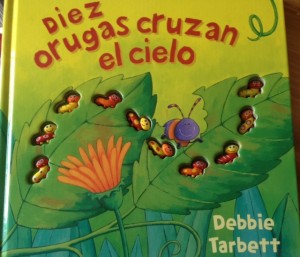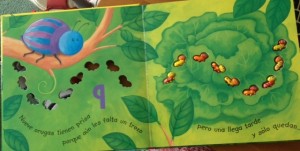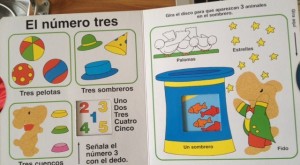Favourite books for PLL – Counting ovejas / Diez orugas cruzan el cielo / Descubre y aprende los números con Fido
*This is one of a series of posts about some of my favourite story books for Primary Language Learning*
Following on from some ideas for Spanish books using colours, the books in this post look at numbers 1-10.
Counting ovejas (available on Amazon and Abebooks) is a book about a little boy who can’t get to sleep as there’s too much noise so he decides to count sheep. Except these sheep aren’t in his imagination! Una oveja blanca arrives in his room and he bids it ¡Adiós! , then dos ovejas amarillas walk in; he bids them ¡Adiós! as he pushes them out of the window. More and more sheep of varying colours arrive and the boy bids them ¡Adiós! in ever increasingly ingenious and elaborate ways. Does he ever get to sleep? you’ll have to read the book to find out!
The text is very simple and very repetitive, following the structure of stating the number and colour of the sheep on one page and bidding them goodbye on the next. In fact the whole book is made up of the following vocabulary:
los números – uno / dos / tres / cuatro / cinco / seis / siete / ocho / nueve / diez
una oveja / ovejas
los colores – blanco / marrón / negro / rosa / verde / rojo / turquesa / violeta / azul / amarillo
¡Buenas noches! ¡Adiós! ¡gracias!
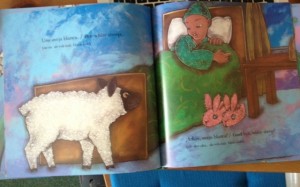
There is a ‘pronunciation’ given on each page for the Spanish; I personally don’t like these as their accuracy depends on everyone interpreting the ‘phonetic spelling’ in the same way. For example seis ovejas rojas is written ‘pronounced’ say-ees oh-veh-hahs ro-has
However it’s a lovely book for reading with young learners who will soon recall the colour of the sheep as well as the next number as you count the invading woolly creatures! It’s a great book for acting with masks too, perhaps for an assembly! And although this post is about another (similar) book, the activities are equally valid!
Diez orugas cruzan el cielo (available on Amazon and Abebooks) is another counting book with little caterpillars traveling through the pages. Each double page is written in four line rhyme with the final word of line 4 being the number of caterpillars left on the next page:
One caterpillar falls asleep, gets lost, or gets left behind on each page so the numbers decrease from diez to uno until there’s a big surprise on the last page. I like this as counting backwards is more tricky than forwards and adds variety to number work.
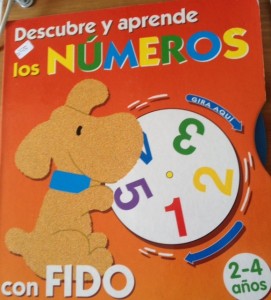
The final counting book for young learners is Descubre y aprende los números con Fido. This book is similar to Descubre y aprende los colores con Fido and particularly good for small groups or individual reading, or for whole class using a visualiser. And as the numbers only go as far as 5, it’s particularly good for very young learners in Nursery/Kindergarten.
Each double page focuses on a different number and has bright images for counting, a panel of numbers for indicating the correct figure and a wheel for finding the correct image to fill the window. You could extend the activities by asking learners to find a certain number of items e.g. dos ovejas or tres vacas from the farm, or cuatro coches y un tren from the transport corner. Or count the number of steps to reach certain parts of the classroom/playground.
A fun book – I’m sure there are plenty of other similar books that could be used for similar activities.
I’ll be back with some French ideas once I’ve found all my French books!
And to finish, a few videos that could be used with these books –
Very simple presentation of Los números 1-10
httpv://youtu.be/BYwiPoJ-Kt8
and also
httpv://youtu.be/_-xcLo49w3E
Un elefante se balanceaba
httpv://youtu.be/ZkEuxLfwl4E
And a counting song (NB Mexican accent)
httpv://youtu.be/8ydJr1Is8xI

